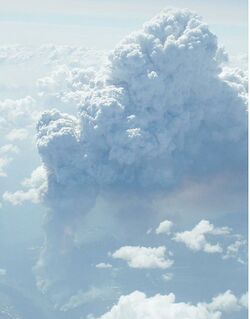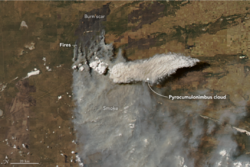Earth:Cumulonimbus flammagenitus (cloud)

The cumulonimbus flammagenitus cloud (CbFg) is a type of cumulonimbus cloud that forms above a source of heat, such as a wildfire, and may sometimes even extinguish the fire that formed it.[citation needed] It is the most extreme manifestation of a flammagenitus cloud. According to the American Meteorological Society’s Glossary of Meteorology, a flammagenitus is "a cumulus cloud formed by a rising thermal from a fire, or enhanced by buoyant plume emissions from an industrial combustion process."[2] Analogous to the meteorological distinction between cumulus and cumulonimbus, the cumulonimbus flammagenitus is a fire-aided or –caused convective cloud, like a flammagenitus, but with considerable vertical development. The CbFg reaches the upper troposphere or even lower stratosphere and may involve precipitation (although usually light),[citation needed] hail, lightning, extreme low-level winds, and in some cases even tornadoes.[3]
The CbFg was named following the discovery in 1998,[4] that extreme manifestations of this pyroconvection caused direct injection of large abundances of smoke from a firestorm into the lower stratosphere.[5][6][7][8][9][10] The aerosol of smoke comprising CbFg clouds can persist for weeks, and with that, reduce ground level sunlight in the same manner as the “nuclear winter" effect.[11][12] A cumulonimbus flammagenitus may often form from the eruption column of a volcano.
In 2002, various sensing instruments detected 17 distinct cumulonimbus flammageniti in North America alone.[13]
Alternate spellings and abbreviations for cumulonimbus flammagenitus that may be found in the literature include Cb-Fg, pyrocumulonimbus, pyro-cumulonimbus, pyroCb, pyro-Cb, pyrocb, and pyro-cb. [citation needed] The World Meteorological Organization does not recognize the cumulonimbus flammagenitus as a distinct cloud type, but instead classifies it simply as cumulonimbus.
2003 Canberra Firestorm
On 18 January 2003, a supercell thunderstorm formed from a cumulonimbus flammagenitus cloud[citation needed] associated with a severe wildfire, during the 2003 Canberra bushfires in Canberra, Australia. The supercell resulted in a large fire tornado, rated at EF3 on the fujita scale, the first confirmed violent fire tornado.[14][15] The tornado and associated fire killed 4 people and injured 492.
See also
- Atmospheric convection
- Flammagenitus
References
- ↑ Fromm, Michael; Alfred, Jerome; Hoppel, Karl et al. (May 1, 2000). "Observations of boreal forest fire smoke in the stratosphere by POAM III, SAGE II, and lidar in 1998". Geophysical Research Letters (Washington, D.C.: American Geophysical Union) 27 (9): 1407–1410. doi:10.1029/1999GL011200. Bibcode: 2000GeoRL..27.1407F. Archived from the original on January 6, 2009. https://web.archive.org/web/20090106220611/http://www.cpi.com/remsensing/midatm/smoke.html. Retrieved August 29, 2013.
- ↑ "AMS Glossary". American Meteorological Society. http://amsglossary.allenpress.com/glossary/search?query=pyrocumulus. Retrieved 6 January 2012.
- ↑ Fromm, M.; Tupper, A.; Rosenfeld, D.; Servranckx, R.; McRae, R. (2006). "Violent pyro-convective storm devastates Australia's capital and pollutes the stratosphere". Geophysical Research Letters 33 (5). doi:10.1029/2005GL025161. Bibcode: 2006GeoRL..33.5815F.
- ↑ "The untold story of pyrocumulonimbus, 2010". http://journals.ametsoc.org/doi/pdf/10.1175/2010BAMS3004.1.
- ↑ Fire-Breathing Storm Systems. NASA
- ↑ Averill, Clare; Logan, Jennifer (August 19, 2004). "Smoke Soars to Stratospheric Heights". Earth Observatory. NASA. http://earthobservatory.nasa.gov/IOTD/view.php?id=4755. Retrieved March 10, 2013.
- ↑ Fromm, Michael; Alfred, Jerome; Hoppel, Karl et al. (May 1, 2000). "Observations of boreal forest fire smoke in the stratosphere by POAM III, SAGE II, and lidar in 1998". Geophysical Research Letters (Washington, D.C.: American Geophysical Union) 27 (9): 1407–1410. doi:10.1029/1999GL011200. Bibcode: 2000GeoRL..27.1407F. Archived from the original on January 6, 2009. https://web.archive.org/web/20090106220611/http://www.cpi.com/remsensing/midatm/smoke.html. Retrieved August 29, 2013.
- ↑ Fromm, M.; Stocks, B.; Servranckx, R. et al. (2006). "Smoke in the Stratosphere: What Wildfires have Taught Us About Nuclear Winter". Eos, Transactions, American Geophysical Union (Washington, D.C.: American Geophysical Union) 87 (52 Fall Meet. Suppl.): Abstract U14A–04. Archived from the original on October 6, 2014. https://web.archive.org/web/20141006085234/http://www.agu.org/meetings/fm06/fm06-sessions/fm06_U14A.html.
- ↑ Fromm, M.; Servranckx, R. (2003). "Transport of forest fire smoke above the tropopause by supercell convection". Geophysical Research Letters 30 (10). doi:10.1029/2002GL016820. Bibcode: 2003GeoRL..30.1542F.
- ↑ Jost, Hans-Jürg; Drdla, Katja; Stohl, Andreas et al. (June 2, 2004). "In-situ observations of mid-latitude forest fire plumes deep in the stratosphere" (PDF). Geophysical Research Letters (Washington, D.C.: American Geophysical Union) 31 (11). doi:10.1029/2003GL019253. CiteID L11101. Bibcode: 2004GeoRL..3111101J. http://www.espo.nasa.gov/docs/crystalface/Jost2004.grl.pdf. Retrieved August 31, 2013.
- ↑ Fromm, M.; Tupper, A.; Rosenfeld, D.; Servranckx, R.; McRae, R. (2006). "Violent pyro-convective storm devastates Australia's capital and pollutes the stratosphere". Geophysical Research Letters 33 (5). doi:10.1029/2005GL025161. Bibcode: 2006GeoRL..33.5815F.
- ↑ Fromm, M.; Stocks, B.; Servranckx, R. et al. (2006). "Smoke in the Stratosphere: What Wildfires have Taught Us About Nuclear Winter". Eos, Transactions, American Geophysical Union (Washington, D.C.: American Geophysical Union) 87 (52 Fall Meet. Suppl.): Abstract U14A–04. Archived from the original on October 6, 2014. https://web.archive.org/web/20141006085234/http://www.agu.org/meetings/fm06/fm06-sessions/fm06_U14A.html.
- ↑ Fire-Breathing Storm Systems. NASA
- ↑ Anja Taylor (6 June 2013). "Fire Tornado". Australian Broadcasting Corporation. http://www.abc.net.au/catalyst/stories/3774941.htm. Retrieved 6 June 2013.
- ↑ McRae, R; Sharpies, J; Wilkies, S; Walker, A (12 October 2012). "An Australian pyro-tornadogenesis event". Nat Hazards 65 (3): 1801. doi:10.1007/s11069-012-0443-7. https://link.springer.com/article/10.1007%2Fs11069-012-0443-7#. Retrieved 4 September 2016.


